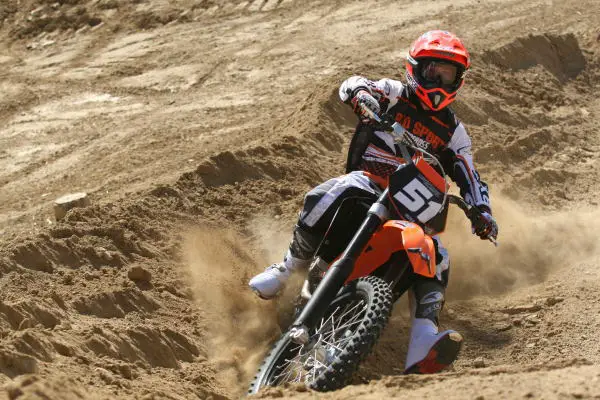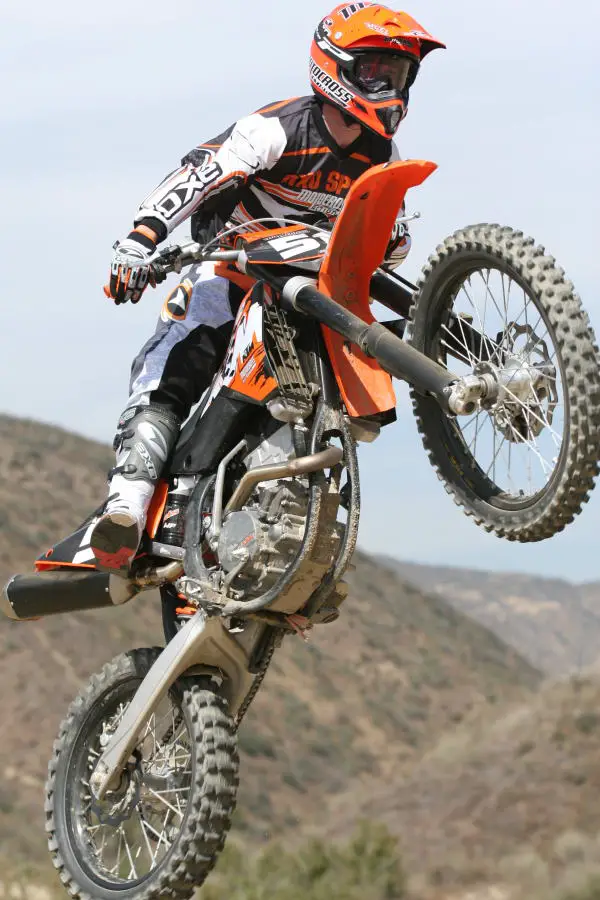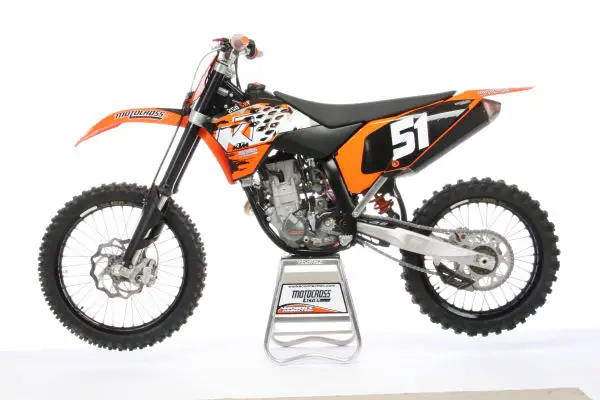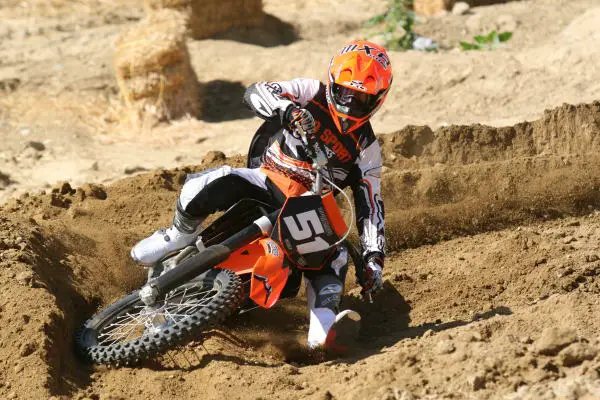2008 RACE TEST KTM 250SXF
It might seem like a distant memory, but KTM was the last of the “Big Five” manufacturers to enter the 250cc four-stroke fold, introducing their 250SXF a year-and-a-half after every other brand. Coming into the market last has advantages and disadvantages. One advantage was that KTM could study their competition and go through every other 250F with a fine-tooth comb, learning and applying the knowledge gained to their own creation. One disadvantage was that KTM was behind the eight ball, losing valuable market share in an industry where 250F’s have quickly taken over as the fastest-growing displacement motocross bike to buy.
Released in June 2005, the KTM 250SXF immediately set itself apart from the competition with its hydraulic clutch, steel frame, finger follower valve train, one-piece swingarm, no-link shock and WP suspension. Since that initial limited-release, KTM has continued to update their 250F by making a number of changes, both big and small, that have elevated its worth in the competitive 250F market.
Q:WHAT’S NEW FOR 2008?
A:Here is a quick list of 2008 KTM 250SXF modifications:
Engine: There is new camshaft timing (increased power), stiffer valve springs (maximizing reliability), quieter muffler (refined for updated sound restrictions), larger diameter head pipe (for better top-end) and all-new ignition curves (for improved throttle response at low rpm).
Chassis: The 2008 KTM gets a new handlebar bend (Renthal 996), strengthened front fender (decreases flex and movement) and wraparound fork guards (increased protection of the fork legs).
Suspension: WP provides a refined fork design (more progressive feeling), low-stiction fork seals (for a smoother feel), improved bushing seals in outer tubes (reduces friction and improves initial action), low-friction shock seals (improves sealing), aluminum shock body tube, and modified transfer holes from the shock body to the reservoir (smoothes out the damping curve).
KTM didn’t go off the deep end making huge changes to the 250SXF; instead they pinpointed certain areas of the bike and tried to improve on those weaknesses.
Q:HOW FAST IS THE ENGINE?
A:This is going to sound confusing, but it is both slow and fast. How is that possible? Off the bottom, the KTM 250SXF builds power with so little hit that it almost feels anemic. It is a sleeping giant that doesn’t want to wake up. At low rpm, the engine makes noise, but it’s more of a yawn than a bark. Through the midrange, the KTM 250SXF starts to come alive, although the power is so linear that it doesn’t feel very ferocious. Once the rpm climbs, the engine truly shines. As long as it’s kept in the top-end and revved to the stops, the 250SXF is a potent machine.
It takes ample clutch feathering to ensure that the engine stays in the meat of the powerband, which requires concentration. Once the power falls off, it’s a tedious process to get the 250SXF back on the pipe.
A lot of the sensations coming out of the 2008 KTM 250SXF are misleading. The perfectly linear and smooth powerband disguises the true amount of power the engine makes. It is a very fast, high revving and quick machine?it just doesn’t feel like it.
Q:WHAT WOULD BENEFIT THE 2008 KTM 250SXF ENGINE THE MOST?
A:Without a doubt, the 2008 250SXF engine would be worlds better with different gearing. The MXA wrecking crew already knew this, because we encountered the same problem on last year’s KTM. The 250SXF’s 13/48 gearing doesn’t make the most of KTM’s six-speed transmission. This bike needs an extra tooth on the rear sprocket, and there are some tracks where we think two teeth would work better.
Slapping a 49-tooth rear sprocket on the 250SXF breathes life into the hidden power of the KTM engine. Instead of hitting corners in second gear and having to gamble on whether the bike would pull third, we could attack the same corner in third and rocket out of the turns.
Q:HOW MUCH DOES THE 2008 KTM 250SXF WEIGH?
A:For the second year in a row, KTM holds the honor of having the lightest 250 four-stroke made. In 2007, KTM shaved over five pounds off the 250SXF, and for 2008 they chopped another pound (by losing weight in the shock). It weighed 211 pounds dry. Can you say Trim Spa, baby?
Q:HOW IS THE JETTING?
A:We had very little problem with the 250SXF’s 39mm Keihin FCR carburetor, in that it was set up well for warm weather riding. In cooler conditions the carb will require a richer pilot jet and possibly a few clips on the needle.
MXA’s recommended jetting is as follows (stock settings are in parenthesis):
Main: 172 (175)
Pilot: 42 (40 stock)
Needle: OBETP
Clip position: Fourth from top
Fuel screw: 1-1/2 turns (1 turn)
Q:HOW WELL DO THE WP SXS FORKS WORK?
A:This is a loaded question. Why? Last year we complained that the WP forks were undersprung. They would drop into their stroke and bottom with regularity. A year ago we replaced the 0.44 kg/mm springs with 0.46s and lowered the oil height by 15cc. This remedied the problem.
For 2008, KTM upgraded to MXA’s 0.46 fork springs and stiffened the valving. But they failed to lower the oil height. The WP units are much better suited to hard riding with the 0.46 springs, but the forks suffer from incredible midstroke harshness. They are almost jarring. We dropped the oil level by 15cc to smooth out the wall of damping.
Q:WHAT ARE MXA’S RECOMMENDED KTM 250SXF FORK SETTINGS?
A:Here is what the MXA wrecking crew ran in its 2008 KTM 250SXF. Stock settings are in parenthesis.
Spring rate: 0.46 kg/mm
Oil height: 375cc (390cc)
Compression: 15 clicks out (14 out)
Rebound: 21 clicks out
Fork leg height: 5mm up
Notes: When the forks are new, they need about an hour of riding to break in.
Q:WHAT DID KTM CHANGE ON THE REAR SUSPENSION?
A:KTM made four changes to the 2008 KTM 250SXF’s WP shock. (1) They used low-friction shock seals to improve sealing. (2) They switched to an aluminum shock body tube. (3) They modified the transfer holes from the shock body to the reservoir to improve oil flow. (4) They upped the shock spring rate from last year’s 6.3 kg/mm to this year’s 6.6.
Of the four changes, the spring rate was far-and-away the most warranted. Heavier riders (over 160 pounds) loved the stiffer shock spring, as did intermediate and pro-level riders. Lighter and less skilled riders might want to revert back to the 6.3 kg/mm spring that came stock on the 2007 250SXF.
Q:WHAT IS MXA’S RECOMMENDED KTM 250SXF SHOCK SETTING?
A:Here is what the MXA wrecking crew ran in its 2008 KTM 250SXF. Stock settings are in parenthesis.
Spring rate: 6.6 kg/mm
Race sag: 107mm
High-compression: 1-1/4 turns out (1 turn out)
Low-compression: 16 clicks out
Rebound: 21 clicks out (23 out)
Q:HOW DOES IT HANDLE?
A:When KTM designed their new oval tube steel frame they solved most of their previous handling flaws. It feels extremely light (because it actually is), and the forks and shock work well in unison (once you drop the oil height in the forks). The 250SXF is stable at speed and does not oversteer or understeer. For 2008, KTM also uses taller bend Renthal FatBars (996), which eliminated the stinkbug feel.
Our only complaint about the handling was how the 250SXF reacted in situations involving braking bumps. In consecutive braking bumps, especially when the chassis was unloaded, the 250SXF had the bad habit of stepping out in the rear. Amazingly, we didn’t experience this torque reaction when the throttle was on or the bumps were big?only when we chopped.
Q:WHAT DID WE HATE?
A:The hate list:
(1) Forks. They are sprung properly now, but there is too much oil in the forks, which leaves them feeling extremely harsh from the midstroke on. KTM needs to change the stock oil height spec or revalve the midstroke.
(2) Hot start lever. KTM should leave the cheesy plastic to Fisher-Price. The hot start lever will snap off the first time that you lay the 250SXF down in the dirt.
(3) Side panels. We don’t know about you, but we need numbers on the sides of our bikes to get scored. On a KTM, this is a problem. Maybe in Europe they don’t have to have side number plates, but in America you do.
(4) Seat. The seat foam on the 250SXF is paper thin. Thicker seat foam would lessen the uncomfortable feeling. We felt like we were sitting on the subframe rails. While we are at it, the seat cover ripped after three rides and wore through on the edges after a couple months.
(5) Bottom-end power. The KTM 250SXF needs more snap, crackle and pop off the bottom, which would in turn make it more fun to ride.
(6) Shock collar. Aluminum is lighter than steel, but we’d prefer to have a shock collar designed to take a blow rather than weighing less. While changing the sag on the KTM, we shredded the aluminum shock collar.
(7) Gearing. KTM stuck to their guns and stayed with 13/48 gearing, but the 250SXF greatly benefits from being geared down.
Q:WHAT DID WE LIKE?
A:The like list:
(1) Front brake. KTM has the best OEM front brake in the business. It is so strong that it trumps most factory bike front brakes. Yes, it’s that strong!
(2) Hydraulic clutch. The Magura clutch is as smooth as butter and doesn’t fade during a long moto. Hallelujah!
(3) Transmission. The 250SXF has a six-speed transmission, which no other 250F can brag about. It’s a beautiful thing (as long as you add a tooth to the rear sprocket).
(4) Fork guards. KTM introduced new fork guards, which practically cover the entire fork leg. Better yet, they look way better than those old-school, plastic, accordion-style fork boots.
(5) Gas cap. In an effort to be different, KTM shot themselves in the foot last year by creating a leaky quarter-turn gas cap. For 2008, the gas cap was redesigned not to leak, but it has a pushbutton lock on it. Too much already. It’s just a cap.
(6) Tires. We said it last year, and we’ll say it again. Bridgestone’s M59/M70 combo is good, despite being rather outdated. The sneakers work well on soft-to-intermediate terrain.
Q:WHAT DO WE REALLY THINK?
A:KTM’s engineers deserve a pat on the back for stiffening up the suspension, going to a taller-bend handlebar, dropping an additional pound off the bike and refusing to conform to what every other manufacturer is doing. Now they need to punch up the powerband, gear it lower and tone down the damping. With a little bit of help, it could be a world-beater. o









Comments are closed.